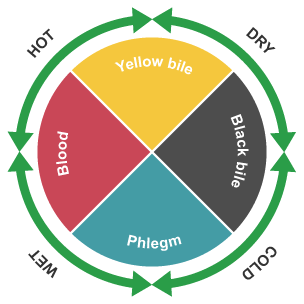Hippocrates and Galen
1/16
Earn XP
Description and Tags
Name | Mastery | Learn | Test | Matching | Spaced |
|---|
No study sessions yet.
17 Terms
Who was Hippocrates?
A Greek doctor born around 460BC
What was Hippocrates sometimes called?
The ‘father of modern medicine’
What did Hippocrates develop?
The Hippocratic Oath and the Four Humours
What was the Hippocratic Oath?
Doctors had to promise that they will do their best to treat patients and keep information confidential
What was the Four Humours?
The idea that the body was made up of four substances - blood, phlegm, yellow bile and black bile - and if any one of these substances was out of balance, the body would become ill
What positive impact did Hippocrates make?
He encouraged doctors to seek natural cures and causes of illness and developed clinical observation of the patient
How do we know about Hippocrates’ ideas?
They were written down in a series of books and copied by monks over hundreds (and even thousands) of years
Who was Galen?
A Roman doctor born in 129 AD who developed the theory of opposites
What was the Theory of Opposites?
This was a method of treating illness that could be used alongside rebalancing the humours by reducing which substance had accumulated too much in the body
How was the Theory of Opposites implemented?
The four humours were linked to the seasons and had a temperature and dryness linked to them, as seen in the photo. If one was out of balance, then a treatment involving the opposite temperature and wet/dry was given
E.g. if there was too much phlegm in the body, which was cold and wet, then something hot and dry would be made the treatment, such as a chilli

How were the four humours rebalanced?
This could be done by bloodletting or purging, which was vomiting, and sometimes laxatives were given too
How did Galen make his discoveries?
He worked on the anatomy of pigs, monkeys and other animals (but never humans)
Why didn’t Galen dissect humans?
In the Roman Empire, human dissection was banned
What did Galen believe through his anatomical studies?
That the human jaw bone was two bones and he believed that there were tiny holes in the septum (which separated the two halves of the heart) to allow blood to pass from one area to another
Why were some of Galen’s ideas wrong?
He didn’t use enough medical experimentation and the anatomy of pigs is very different than that of humans
Why was Galen so popular and widely believed through the Middle Ages?
Many of his books survived the fall of the Roman Empire, and he was a Christian so supported the ideas of the church. The fact that his books were preserved through time enabled him to become highly respected and the church discouraged experimentation, so Galen’s ideas were the most recent medical studies until the Renaissance period!
How long did his influence last for?
His work formed the basis of the training of doctors for 1400 years!